CHICAGO WEEK 1-2
Chicago is so much more than an iconic downtown area and deep-dish pizza, but of course, both are a must for everyone visiting The Windy City! Check out some of my favorite things to see and do in Chicago, from innovative architecture in Millennium Park to vibrant street art at the Wabash Arts Corridor.
STUFFED DEEP PAN PIZZA – OH MY!
The first week in Chicago was a little rough. Like when the magic and excitement of the “Honeymoon period” is suddenly over. Friday night, we drove north of downtown Chicago to Montrose Beach to get a look at the iconic Chicago skyline from the shores of Lake Michigan. Not exactly the ocean but a pretty and peaceful spot to end the week.
We had Giordano’s stuffed deep-dish pizza for dinner – leftovers from Thursday night. Allan insisted on buying a medium-sized pizza, and it turned out to be massive. I can’t put enough emphasis on how delicious Chicago pizza is. The thick, perfectly crisp, pie-like crust is stuffed with savory fillings, gooey mozzarella, and spicy tomato sauce. I think Lou Malnati’s is supposed to be the most famous deep-dish Chicago pizza, but we never made it beyond Giordano’s. So good!
the L-train to downtown Chicago
Saturday morning, we took the L-train from Logan Square to downtown Chicago. Public transportation is an easy way to get to and from downtown. I have to admit that subways make me feel a little uneasy. The stark contrast to the street level with the dimly lit corridors. The squeaking sounds of trains. The bustling crowds of people in transit. However, I got used to it.
We spent the entire day in the “Windy City”. It was a beautiful sunny day with crisp blue skies and a sense of early Fall in the air. I photographed the city’s iconic skyline from pretty much all possible angles, fascinated by the impressive architecture. A cool mix of historic and modern buildings like The Willis Tower, the John Hancock Center, and the Aon Center.

Downtown Chicago architecture
Iconic bridges at the Chicago Riverwalk
The Chicago River runs through the downtown area, and we walked along the riverbank on the scenic Chicago Riverwalk. At times we stopped for a break at some of the beautifully landscaped recreational spaces. Watched the locals as well as tourists enjoying this peaceful urban escape in the heart of the city, soaking up the sun. Some say that Chicago’s legendary architecture is best experienced from the river, on a guided boat tour. A large number of companies offer these tours every day.
A network of iconic bridges spanning across the river and connects different parts of the city making Chicago even more impressive. Michigan Avenue and the Wells Street Bridge are both movable drawbridges that allow boats to pass underneath. Other bridges like Columbus Drive Bridge and DuSable Bridge are fixed bridges, all well-known for their architectural diversity and significance in Chicago’s history.
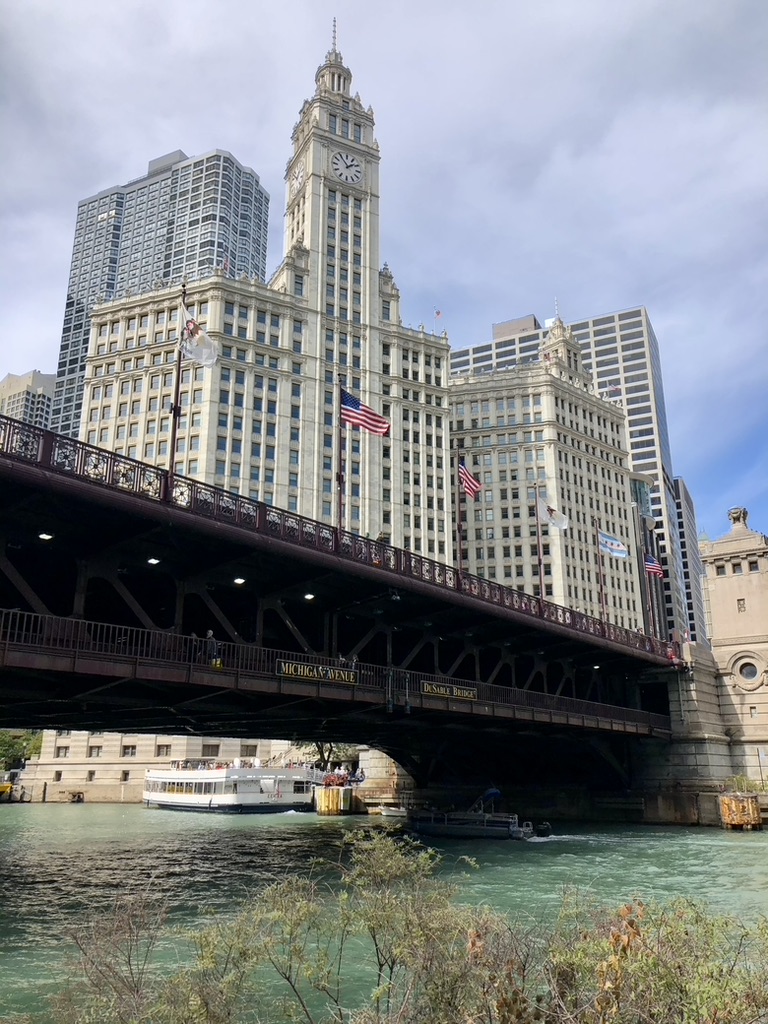
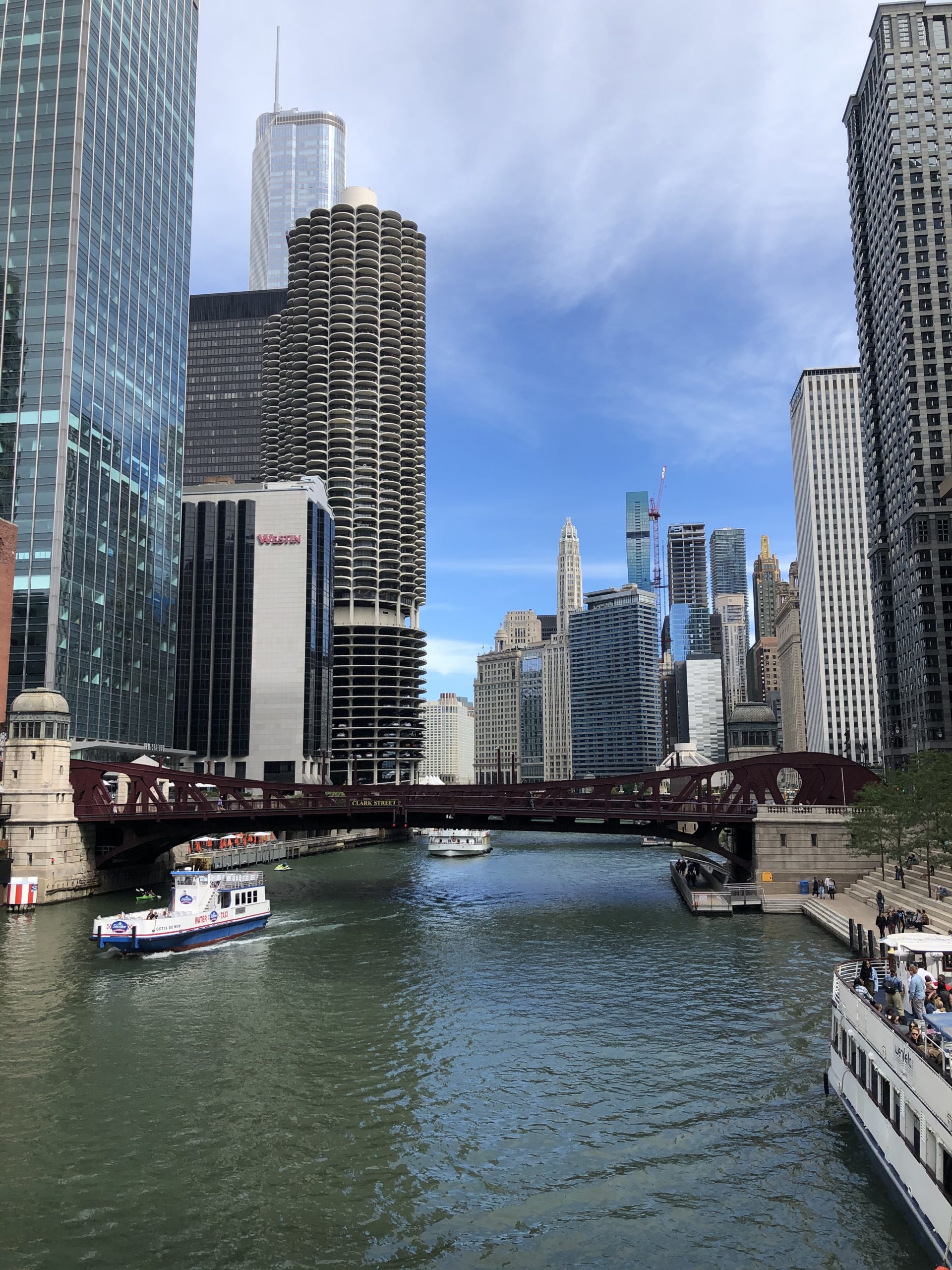
Iconic buildings and bridges at the Chicago Riverwalk
sightseeing around millennium park
The BP Pedestrian Bridge, a winding, futuristic stainless-steel bridge led us to the Millennium Park. The bridge has great views of both the city and the lakefront. Millennium Park is a great place to stroll around and experience various art installations like the Crown Fountain, two 50-foot glass towers displaying digital video images; Laurie Garden, a natural oasis with a cascading waterfall and a footbridge; and the Jay Pritzker Pavilion, an impressive concert venue characterized by distinctive steel ribbons and open-air design.
Millennium Park has a particular iconic feature, Cloud Gate or “The Bean”, The Bean is a large polished stainless-steel sculpture by British artist Anish Kapoor. This mirrored structure is like a giant droplet of liquid mercury, and the reflections of the city’s skyline are mesmerizing. It invites visitors to interact with the smooth, reflective surface creating a kaleidoscope of colors and shapes.

BP Pedestrian Bridge in Millenium Park

Cloud Gate, “The Bean” in Millennium Park
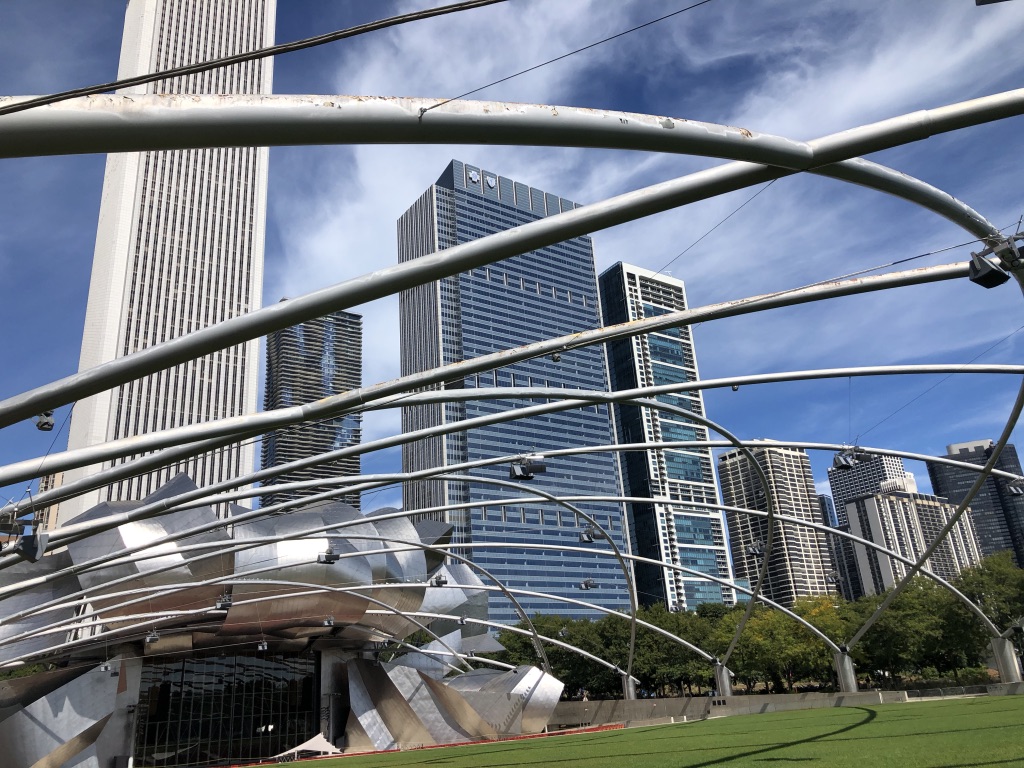
Jay Pritzker Pavillion in Millennium Park
Lunch and Willis Tower
The Chicago food scene is diverse, dynamic, and delicious with a wide range of flavors, cuisines, and culinary experiences for every taste and budget. While sightseeing we randomly found The Dearborn, a cool, urban tavern, serving Midwestern seasonality and creative drinks.
Later in the afternoon, we walked to the Willis Tower, (formerly known as the Sears Tower) a 110-story, 1,451-foot (442.3 m) skyscraper in the Loop community area. The Willis Tower is one of the tallest buildings in the United States, characterized by its black aluminum and bronze-tinted glass exterior. Impressive inside as well as outside.
We were hoping to see the panoramic views of the city and Lake Michigan from the “floating” glass boxes on the 103rd floor, but the numbers of visitors were limited because of COVID-19, and the lines were too long. We decided to come back another day, which unfortunately never happened.

Wabash Arts Corridor – an Urban art space
Instead, we went hunting for street art in the Wabash Arts Corridor. This is a dynamic urban art space, in the South Loop neighborhood, known for its large-scale murals covering entire building facades. It stretches along Wabash Avenue between Van Buren Street and Roosevelt Road. See the map here. Columbia College Chicago is located within the corridor and launched the corridor in 2013 as a platform for students using urban spaces
Somewhere between the Wabash Arts Corridor and a red velvet cupcake from Molly’s Cupcakes, we both got tired. It had been a long and intense day with miles and miles of walking. The wireless signal on our mobile phones was weakened by the tall buildings and we started acting like little kids, trying to figure out how to get back to Logan Square.
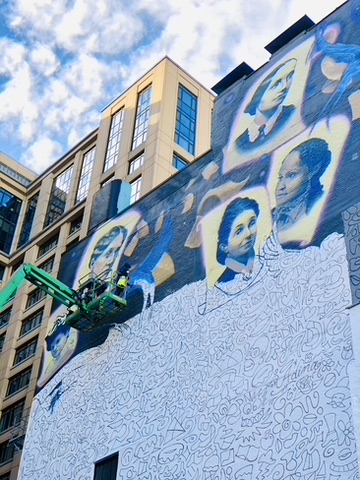

Mural in the making at the Wabash Arts Corridor
Logan Square Farmers Market
The next morning, we walked to the Farmer’s Market at Logan Square. It’s a small outdoor community market offering a wide variety of fresh produce, artisanal goods, prepared foods, and handmade crafts. We bought some ham and cheese croissants and enjoyed the delicious fresh baked goods, sitting on the steps of the Logan Square monument. A funky Chicago band was playing, and in my opinion, it was the definition of a perfect Sunday morning.
Sunday afternoon at Lincoln Park
Later that day we went to Lincoln Park. We had enough public transportation for one weekend so we took the car, and parking turned out to be pretty easy. Lincoln Park is a neighborhood and recreational area stretching along the north side of Lake Michigan with a zoo, gardens, a pond, a historic indoor botanical garden, and lakefront green spaces.
The Lincoln Park Zoo is admission-free, easily accessible, and a popular spot for families to enjoy a diverse range of animals from around the world. My favorite part was the scenic walking paths around the pond which offered incredible views of the city. A great place for a couple of empty nesters to spend a Sunday afternoon. Lincoln Park Conservatory, right next to the zoo, unfortunately closed while we were there, but looks like it could be worth a visit.



Chicago skyline from Lincoln Park
Dinner in West Town
For dinner, we headed to eclectic and artsy West Town, another great place to discover amazing street art. We walked around the neighborhood until our table was ready at Beatnik. Somehow we never learned to make a reservation, and who knew that this place would be so popular on a Sunday night? We’ve had several great culinary experiences while traveling, but Beatnik in West Town (There is a second location downtown) stands out, with its eclectic bohemian décor and a mix of flavors from various cultures. Loved it!
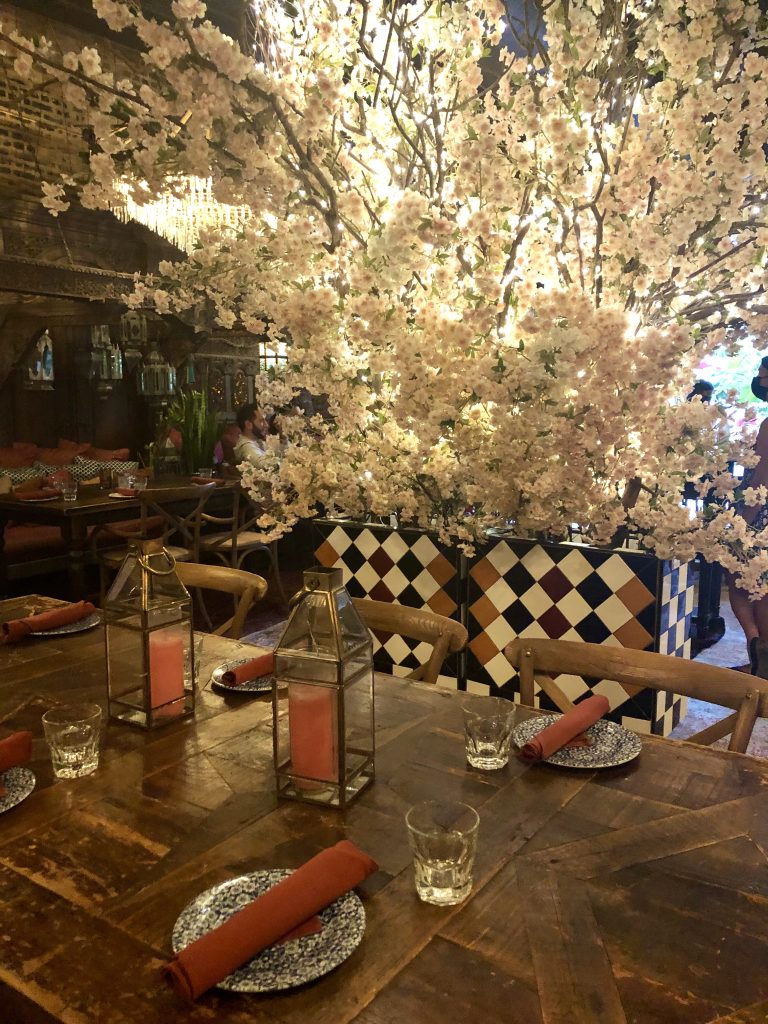


Culinary experience at restaurant Beatnik in West Town
Read more about other amazing places in and around Chicago
From vibrant street art to bold Barbara Kruger exhibition
How to have a fun weekend of blues, art, and culture in Chicago

